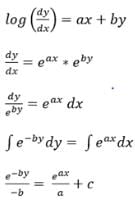JEE Advanced Level Test: Vector Algebra- 1 - NDA MCQ
30 Questions MCQ Test Mathematics for NDA - JEE Advanced Level Test: Vector Algebra- 1
The degree of the differential equation satisfying 
The differential equation whose solution is Ax2 + By2 = 1, where A and B are arbitrary constants, is of
Differential equation of the family of circles touching the line y = 2 at (0, 2) is
The differential equation of all parabolas whose axis are parallel to the y-axis is
The differential equation of all circles which pass through the origin and whose centers lie on the y-axis is
The differential equation whose general solution is given by, y = , where c1, c2, c3, c4, c5 are arbitrary constants, is
The equation of the curves through the point (1, 0) and whose slope is
The solution of the equation log(dy/dx) = ax + by is
Solution of differential equation dy – sin x sin ydx = 0 is
The general solution of the differential equation
The solutions of (x + y + 1) dy = dx is
The slope of the tangent at (x, y) to a curve passing through then the equation of the curve is
The solution of (x2 + xy)dy = (x2 + y2)dx is
The solution of (y + x + 5)dy = (y – x + 1) dx is
The slope of the tangent at (x, y) to a curve passing through a point (2, 1) is then the equation of the curve is
The solution of satisfying y(1) = 1 is given by
A function y = f(x) satisfies then f(x) is
The curve satisfying the equation and passing through the point (4, - 2) is
The solution of the differential equation
Which of the following is not the differential equation of family of curves whose tangent from an angle of π/4 with the hyperbola xy = c2?
Tangent to a curve intercepts the y-axis at a point P. A line perpendicular to this tangent through P passes through another point (1, 0). The differential equation of the curve is
The curve for which the normal at any point (x, y) and the line joining the origin to that point from an isosceles triangle with the x-axis as base is
A normal at P(x, y) on a curve meets the x-axis at Q and N is the foot of the ordinate at P. If NQ = then the equation of curve given that it passes through the point (3,1) is
The equation of the curve passing through (2, 7/2) and having gradient
A normal at any point (x, y) to the curve y = f(x) cuts a triangle of unit area with the axis, the differential equation of the curve is
The differential equation of all parabola each of which has a latus rectum 4a and whose axis parallel to the x-axis is
|
277 videos|265 docs|221 tests
|





















